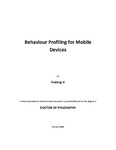Behaviour Profiling for Mobile Devices
| dc.contributor.supervisor | Clarke, Nathan | |
| dc.contributor.author | Li, Fudong | |
| dc.contributor.other | Faculty of Science and Engineering | en_US |
| dc.date.accessioned | 2012-05-28T08:16:23Z | |
| dc.date.available | 2012-05-28T08:16:23Z | |
| dc.date.issued | 2012 | |
| dc.date.issued | 2012 | |
| dc.identifier | 776085 | en_US |
| dc.identifier.uri | http://hdl.handle.net/10026.1/1025 | |
| dc.description.abstract |
With more than 5 billion users globally, mobile devices have become ubiquitous in our daily life. The modern mobile handheld device is capable of providing many multimedia services through a wide range of applications over multiple networks as well as on the handheld device itself. These services are predominantly driven by data, which is increasingly associated with sensitive information. Such a trend raises the security requirement for reliable and robust verification techniques of users.This thesis explores the end-user verification requirements of mobile devices and proposes a novel Behaviour Profiling security framework for mobile devices. The research starts with a critical review of existing mobile technologies, security threats and mechanisms, and highlights a broad range of weaknesses. Therefore, attention is given to biometric verification techniques which have the ability to offer better security. Despite a large number of biometric works carried out in the area of transparent authentication systems (TAS) and Intrusion Detection Systems (IDS), each have a set of weaknesses that fail to provide a comprehensive solution. They are either reliant upon a specific behaviour to enable the system to function or only capable of providing security for network based services. To this end, the behaviour profiling technique is identified as a potential candidate to provide high level security from both authentication and IDS aspects, operating in a continuous and transparent manner within the mobile host environment.This research examines the feasibility of a behaviour profiling technique through mobile users general applications usage, telephone, text message and multi-instance application usage with the best experimental results Equal Error Rates (EER) of 13.5%, 5.4%, 2.2% and 10% respectively. Based upon this information, a novel architecture of Behaviour Profiling on mobile devices is proposed. The framework is able to provide a robust, continuous and non-intrusive verification mechanism in standalone, TAS or IDS modes, regardless of device hardware configuration. The framework is able to utilise user behaviour to continuously evaluate the system security status of the device. With a high system security level, users are granted with instant access to sensitive services and data, while with lower system security levels, users are required to reassure their identity before accessing sensitive services.The core functions of the novel framework are validated through the implementation of a simulation system. A series of security scenarios are designed to demonstrate the effectiveness of the novel framework to verify legitimate and imposter activities. By employing the smoothing function of three applications, verification time of 3 minutes and a time period of 60 minutes of the degradation function, the Behaviour Profiling framework achieved the best performance with False Rejection Rate (FRR) rates of 7.57%, 77% and 11.24% for the normal, protected and overall applications respectively and with False Acceptance Rate (FAR) rates of 3.42%, 15.29% and 4.09% for their counterparts. | en_US |
| dc.language.iso | en | en_US |
| dc.publisher | University of Plymouth | en_US |
| dc.subject | Mobile Device | |
| dc.subject | Authentication | |
| dc.subject | IDS | |
| dc.subject | Transparent | |
| dc.subject | Behaviour Profiling | en_US |
| dc.title | Behaviour Profiling for Mobile Devices | en_US |
| dc.type | Thesis | |
| dc.identifier.doi | http://dx.doi.org/10.24382/4138 |
Files in this item
This item appears in the following Collection(s)
-
01 Research Theses Main Collection
Research Theses Main


